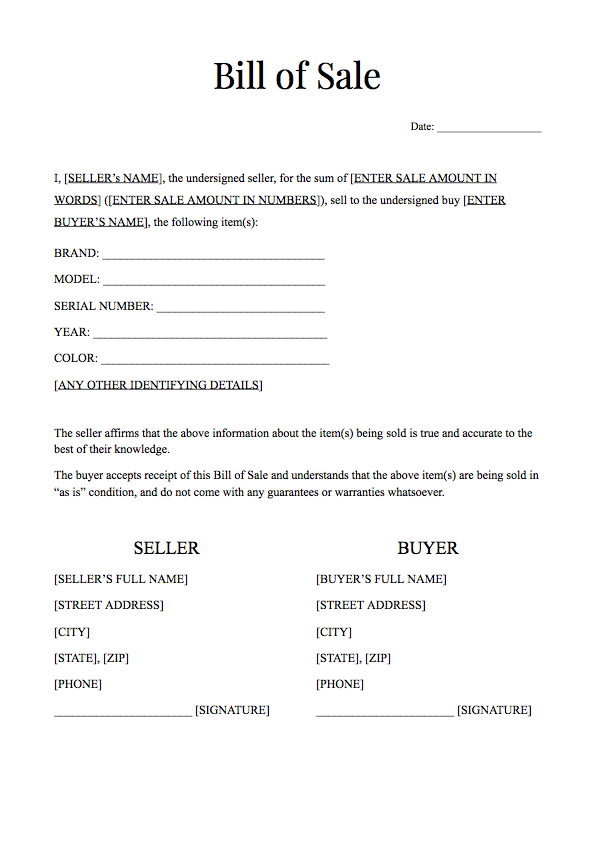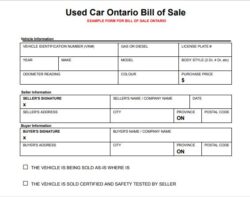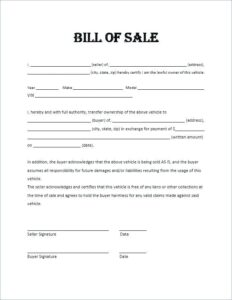Embarking on a transaction, whether you are buying or selling a vehicle, a piece of equipment, or even an antique item, comes with its own set of responsibilities and legalities. In Ontario, having a clear and legally sound record of such a transfer of ownership is not just a good idea; it’s often a necessary step to protect both parties involved. This is where a bill of sale comes into play, serving as a fundamental document for proving the transaction.
A bill of sale provides concrete evidence of the sale, detailing what was sold, by whom, to whom, and for how much. It’s a crucial paper trail that can prevent future disputes, clarify ownership, and even fulfill requirements for government agencies like the Ministry of Transportation when dealing with vehicles. Understanding how to correctly prepare and utilize this document is paramount for a smooth and secure transaction in the province.
The Indispensable Role of a Bill of Sale in Ontario
When you’re dealing with the transfer of property in Ontario, a bill of sale isn’t just a formality; it’s a vital legal instrument. It serves as irrefutable proof of purchase and ownership, protecting both the buyer and the seller from potential future disagreements or legal challenges. For instance, if you’re selling a used car, the bill of sale confirms that the vehicle is no longer your responsibility after a specific date and time, thus absolving you of any incidents that might occur post-sale. For the buyer, it’s the primary document needed to register the vehicle in their name with the Ministry of Transportation, alongside other necessary paperwork like the Used Vehicle Information Package.

Beyond vehicles, a bill of sale is equally important for other high-value items, such as boats, trailers, or even significant personal property. Without it, proving ownership or the terms of the sale could become incredibly challenging if a dispute arises. Imagine purchasing a valuable item without any written proof; if it turns out to be faulty or misrepresented, your recourse would be significantly limited without a formal document detailing the transaction. This document legally binds the terms agreed upon by both parties, ensuring clarity and accountability.
Essential Details for Your Bill of Sale
To ensure your bill of sale is legally sound and effective, it must contain several key pieces of information. Omitting any of these crucial details could weaken the document’s validity and leave room for misinterpretation. Therefore, when creating or using a bill of sale ontario template, pay close attention to accurately filling out each section.
Here are the critical components that should always be included:
* The full legal names and addresses of both the seller and the buyer.
* A comprehensive description of the item being sold, including make, model, year, vehicle identification number (VIN) for vehicles, or serial number for other items.
* The agreed-upon purchase price of the item, clearly stated in Canadian dollars.
* The exact date and time of the transaction, which is particularly important for determining liability for vehicles.
* The signatures of both the seller and the buyer, ideally witnessed by a neutral third party, though a witness is not always legally required for the bill of sale itself to be valid.
Accuracy and completeness are paramount when filling out these details. Any discrepancies or missing information could create complications down the line. For example, an incorrect VIN could lead to issues with vehicle registration, while an unclear description of the item might cause disputes about what exactly was included in the sale. Taking the time to double-check every detail ensures the document serves its purpose effectively.
Finding and Customizing Your Bill of Sale Ontario Template
When you’re ready to create a bill of sale, you don’t necessarily need to draft it from scratch. There are numerous resources available online that offer a suitable bill of sale ontario template, making the process much simpler and ensuring you cover all the necessary legal points. Many government websites, legal aid services, or reputable online legal document providers offer templates that are specifically designed to meet Ontario’s requirements. It’s a great idea to seek out a template that is widely recognized and has been reviewed for legal compliance within the province.
Once you have a template, the next step is to customize it to fit your specific transaction. While the core information—buyer and seller details, item description, price, and date—remains standard, you might need to add specific clauses depending on the nature of the sale. For instance, if you are selling an item “as-is” without any warranties, it is crucial to explicitly state this in the document. This protects the seller from future claims about the item’s condition. Conversely, a buyer might want to ensure certain conditions are met before the sale is finalized, and these too can be incorporated.
Consider the type of item you are selling. A template for a vehicle will naturally include fields for a VIN and odometer reading, whereas a template for a boat might require details about its hull identification number and engine specifications. Tailoring the template ensures that all relevant attributes of the item are documented, reducing ambiguity. This customization process is key to making the document truly effective for your unique situation.
While a template provides an excellent starting point, remember that it serves as a general guide. If your transaction involves complex terms, high-value assets, or unique circumstances, it might be wise to seek legal advice. A legal professional can review your customized bill of sale to ensure it fully protects your interests and complies with all applicable laws in Ontario. They can provide peace of mind, ensuring your transaction is legally sound and hassle-free.
Using a well-structured bill of sale provides both buyers and sellers with a clear, legally recognized record of ownership transfer. It’s an essential part of responsible property transactions in Ontario, offering peace of mind and protection for all parties involved. By taking the time to properly complete this document, you are building a strong foundation for a secure and transparent exchange.



